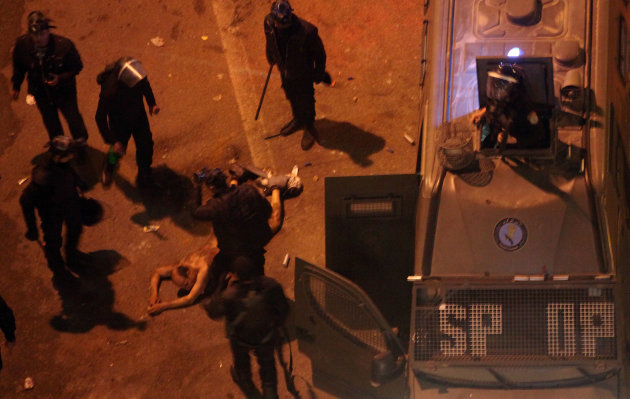For months,
Salaha Najim would discreetly put up a satellite dish banned by the Islamist rebels in dusty
Timbuktu, close the shutters of his house and turn on the television to watch soccer with the sound turned down.
On Saturday, the windows were open wide again and the
volume was unashamedly loud as Mali's national team, the Eagles, beat
South Africa in a penalty shootout to reach the semifinals of the
African Nations Cup.
Timbuktu's residents
poured into the streets to chant and honk horns at the end of an
extraordinary week that began with French troops ending the 10 months of
harsh Islamic rebel rule and finished with football triumph and
thousands cheering a visit by French President Francois Hollande.
"The Islamists
banned everything," said Najim, beaming as he watched the game with two
friends in his brown, flat-roofed house nestled in Timbuktu's warren of
streets. "But now I can watch games as loud as I want."
A lightning three-week offensive by French air and
ground forces has swiftly ended the occupation of Mali's northern towns
by a loose alliance of Islamist rebels linked to al Qaeda's North
African wing, AQIM.
Across Timbuktu,
French and Malian flags now hang side-by-side to celebrate the
liberation and residents cheer the French military convoys that
regularly pass by. The town was for centuries a hub in trans-Saharan
trade and a center of Islamic learning before becoming a tourist magnet
in recent decades.
Street markets
bustle as residents try to replenish store cupboards run down during
months of isolation. But uncertainty lingers over whether Mali's weak
government and army can keep the Islamists at bay once French forces
leave.
ETHNIC RIFTS
Months of conflict have also deepened rifts in the
population. Most light-skinned Arabs and Tuaregs have fled Timbuktu
after reprisal attacks against those accused of backing the Islamists.
"I will only say
they are gone forever once I'm told they've been hunted down," said
Moussa Djikke, an elderly resident sitting in the shade of a tree
between the Sankore mosque and the Baba Ahmed Institute, two pillars of
the town's heritage.
The fleeing
Islamists prompted an international outcry when they ransacked 2,000
ancient manuscripts from the Institute, compounding their destruction of
Timbuktu's sacred Sufi mausoleums, which they considered idolatrous.
Most of the city's 300,000 ancient texts remain intact,
however. "Our culture was being attacked. We were imprisoned. But now
we are free," said Djikke, fingering his prayer beads.
Today the town's residents proudly flout the strict sharia laws the Islamists imposed on them.
Men no longer wear trousers rolled up to just beneath
their knees, in imitation of the Prophet Mohammed. Women are free to
appear unveiled in bright traditional African dress, and people of both
sexes mingle in the streets as they want.
Outside a
streetside stall, residents gather to listen to songs by Haire Arbi, a
popular local singer who fled last year when the Islamists banned music.
Nearby, cigarette sellers are doing brisk trade.
The Hotel Colombe, whose corridors adorned with
pictures of local tourist spots were shut off for months, sprang to life
overnight.
"The day (the Islamists) came into town, they forced us
to shut and destroyed our alcohol," said employee Mahamane Toure.
TEA, BOOKS AND MOSQUE
Under the Islamist occupation, Toure spent his days
drinking tea and reading novels, punctuated only by visits to the
mosque. His beard grew so long it reached almost to his belly button and
he shared what little food he could find with his neighbors.
Then French armored vehicles rolled into town on
January 28 and he opened his doors to the wave of foreign journalists
who followed, filling the hotel's 50 long-abandoned rooms.
"When I woke up that day, I had no idea it would change
so quickly," he said, juggling phone calls. One was an urgent appeal to
a relative in Bamako to dispatch beer as stocks dug up from the desert,
where they had been hidden for months, were already running ran dry.
Amid the relief, the scars of occupation remain. Black
and white billboards bearing Islamist messages still stand by the
roadside. One, at the gates of the town, welcomes residents to the seat
of the application of sharia.
The Malian Solidarity Bank has the word "Police"
scrawled on its beige walls. It served as the headquarters of the
Islamic police, which meted out punishments including whipping and
amputation to those accused of breaking Islamic law.
Residents said the booth for the bank's cash dispenser
had been used to detain female prisoners, sometimes dozens at a time.
Down the road at a
sandy junction, nicknamed "Afghanistan" by locals after it became a
gathering point for heavily armed militants, there are signs of the
ethnic divisions exacerbated by the conflict.
The doors of shops
belonging to Arab traders, accused of having links with the Islamists,
are broken open: looted in the days since the Islamists' departure.
"We used to like
the Arabs. We thought they were good. But we no longer trust them," said
Albert Toure, a 28-year-old who makes leather shoes. "We are tired.
What we now need is security."








 Bruce Davis was 30 years old when he was convicted of participating in
two murders at the behest of Charles Manson. Forty years later, the
California Board of Parole Hearings sent its recommendation to Governor
Jerry Brown that he be released from prison.
Bruce Davis was 30 years old when he was convicted of participating in
two murders at the behest of Charles Manson. Forty years later, the
California Board of Parole Hearings sent its recommendation to Governor
Jerry Brown that he be released from prison. 




 Fearless?
Not if science can help it! Science can scare anybody, even those
who are born with a rare genetic disorder that make them fearless.
Fearless?
Not if science can help it! Science can scare anybody, even those
who are born with a rare genetic disorder that make them fearless.

 It was a jarring moment when generations of young readers got to the fourth book in the Little House
series by Laura Ingalls Wilder and saw that it opened with the simple
statement that her sister Mary had gone blind from scarlet fever.
Ingalls wrote her remembrances late in life for young readers, and many
believe they were heavily edited by Rose Wilder Lane, but what made it
into print left a distinct and frightening impression. But it turns out
that scarlet fever doesn't cause blindness. Dr. Beth A. Tarini
deduced, after a decade of research, that Mary probably went blind in
1879 due to viral meningoencephalitis. But why does it matter so many
years later?
It was a jarring moment when generations of young readers got to the fourth book in the Little House
series by Laura Ingalls Wilder and saw that it opened with the simple
statement that her sister Mary had gone blind from scarlet fever.
Ingalls wrote her remembrances late in life for young readers, and many
believe they were heavily edited by Rose Wilder Lane, but what made it
into print left a distinct and frightening impression. But it turns out
that scarlet fever doesn't cause blindness. Dr. Beth A. Tarini
deduced, after a decade of research, that Mary probably went blind in
1879 due to viral meningoencephalitis. But why does it matter so many
years later?
 Sometimes,
science follows science fiction. Take, for example, the case of "living
crystals," which sounds like a race of alien beings. But thanks to
science, they're now real.
Sometimes,
science follows science fiction. Take, for example, the case of "living
crystals," which sounds like a race of alien beings. But thanks to
science, they're now real.




